Nanomaterials
Nanomaterials
Smallest materials for greatest success
Nanomaterials are so small in size that at least one of their dimensions is below 100 nanometers (nm). To get an idea of what that means, you have to keep in mind that a human hair, for example, is about 80,000 nm wide. Even though nanomaterials are small size, their special properties make them highly interesting for economy and sciences. Especially in industry and research, nanomaterials are in demand like never before. We at PlasmaChem want to contribute to increased integration of nanomaterials in the daily routines in factories and laboratories. Because nanomaterials have the potential to bring progress that is comparable to that of a quantum leap.
Nanomaterials in nature – a model for science
Comparable to many other cases, some nanomaterials also occur in nature and can serve as a model for the synthetic nanomaterials that we work with nowadays. For instance, the fine dust released during a volcanic eruption is full of nanomaterials. In principle, silk consists of nanomaterials, too, and so do the wax crystals on the top surface of a lotus leaf. The scales on a butterfly’s wings are another example for nanomaterials, and so are red blood cells.
The special feature of nanomaterials
What makes these nanomaterials so special is that, due to their small size, they have different physico-chemical properties compared to larger particles of the same chemical composition. The main reason is that particles the size of nanomaterials have, in essence, a substantially enlarged particle surface compared to a product consisting of larger particles. This results in a considerably increased chemical reactivity and biological activity, altered mechanical and electrical properties, and, in addition a strong catalytic behavior.
What are the benefits of nanomaterials in plain text?
Nanomaterials are now in use in many areas. As flow aids and preservatives in foodstuff, light converters in displays and lamps, mechanical enforcement additives in composites, transparent conductive coatings in electronics, and hundreds of other applications. Furthermore, the cosmetic industry uses nanomaterials frequently because of their ability to influence positively the visual effects of cosmetic products. Yet another example are vitamines such as coenzyme Q10. This water-insoluble enzyme becomes water-soluble upon encapsulation in or mixing with some nanomaterials.
Until recently, the current practice was to break down any material one wanted to use in order to release the nanomaterial before re-using it in the final product. Today, many nanomaterials are built synthetically and then inserted into the product. In this way, the production has become much more effective and targeted, especially because nanomaterials can be designed so that they best fulfill their purpose.
Nanomaterials on the global market
In 2011, an estimated 11 million tons of nanoparticles were consumed worldwide as part of the economic use in products and production methods. Tendency increasing. A clear indication of the progress that these tiny materials bring to many areas of the market, economy, technology and research.
PlasmaChem – a pioneer in the field of nanomaterials
We at PlasmaChem have set us the goal to make nanotechnology for the broad markets as safe and appealing as for research. This includes our own research projects in the field of nanomaterials, but also the open and trust-based trade of these products with the existing markets, and the creation of new markets. So that the smallest materials can continue to contribute to the greatest progress.
NanoDiamonds Applications
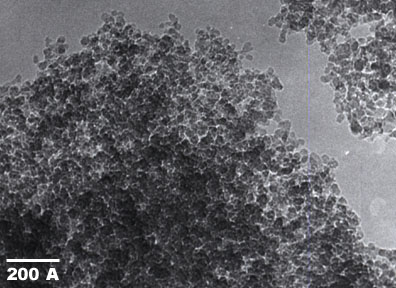 Pure NanoDiamonds and Raw Diamond / Graphite Nanomixture
Pure NanoDiamonds and Raw Diamond / Graphite Nanomixture
Average cluster size ca. 4 nm. Compatible with different media, give stable suspension without caking
Lapping and polishing applications
- Nickel Plated Rigid Memory Disk
- Al-Rigid Memory Disk Substrate
- Polycarbonate and CR-39 Eyeglass Lenses
- Miniature and Precision Ball Bearings
- Optical and Laser Optical Components
- Ceramics
- Orthopedic Prostheses
- Precious Stones
- Honing Microtome Knives
- Stainless Steel Sheet
- Metallic Mirrors and Precision Metal Polishing
- Lapidary Materials
- Acrylic Sheet, Aircraft Windows and Canopies
- Contact Lenses
- Ferrite Surface Preparation
- Mechanical Seal Lapping
- Superhard and Soft Nanoabrasives
- Polishing of PC Hard Disc
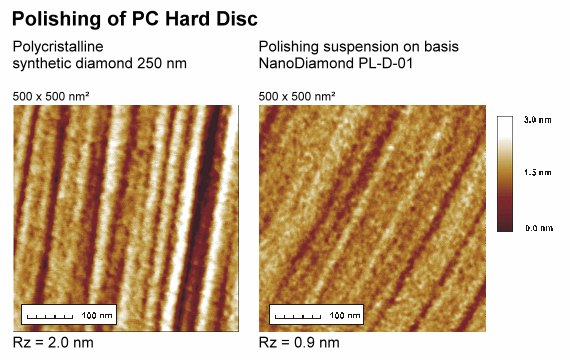
Other applications:
- Surface germination for following growth of diamond-like CDV- and PECVD-films
- Ni-Diamond and Cr-Diamond electroplated hard coatings: sharply improved mechanical properties - reduced metal grain size
- Molecular sieves
- Lubricant additive to engine oil
- Dry lubricants for metal industry (Drawing of W-, Mo-, V-, Rh-wires)
- Reinforcing fillers for plastics and rubbers
- Chromatographic carriers
Metal Plated with Nano-Particles |
Increase of Wear Resistance, Times |
Cr |
2 - 12 |
Ni |
3 - 4 |
Cu |
5 - 7 |
Au |
1.5 - 4 |
Ag |
3 - 6 |
Sn |
2 - 3 |
NanoCeramics Applications
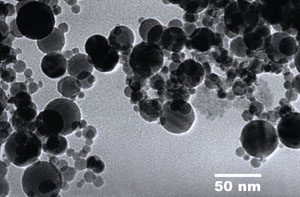 Lapping and polishing applications
Lapping and polishing applications
• Non-carbon nanoabrasives (see "NanoDiamonds")
Other applications:
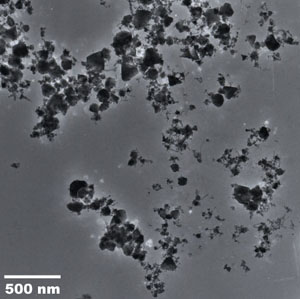
- Low temperature sintering
- New Ceramic alloys
- Ceramic-metal electroplated hard coatings
- Ceramic-reinforced metal alloys
- Cold ceramic nanoglues
- LIGA-technology (micromechanics)
- Bioactive carriers
- Ceramic nanofilters
- Special glasses and crystals
- Oral Dentifrices
- Magnetic Media Ingredient
- Translucent High-Strength Ceramics
- Semiconductor Products
- Floppy Disks, Audio/Video Tapes
NanoMetals Applications
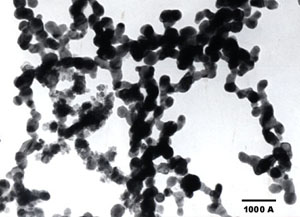 Metal cluster size can be regulated with step 10 nm in range 10-300 nm. Narrow size distribution of spheric particles. Give fine nanoprofiles at sintering.
Metal cluster size can be regulated with step 10 nm in range 10-300 nm. Narrow size distribution of spheric particles. Give fine nanoprofiles at sintering.
Applications:
- Powder metallurgy
- Magnetic nanoliquids, coatings and nanomedia
- Welding joints at 0,4 Tm
- Reinforced glues and composites
- Additives to engine oil
- Primary components for porous heat exchangers
- Metal reusable nanofilters
NanoPowders Applications
Lapping and Polishing Applications |
|
Nickel Plated Rigid Memory Disk |
|
Al-Rigid Memory Disk Substrate |
|
Polycarbonate and CR-39 Eyeglass Lenses |
|
Miniature and Precision Ball Bearings |
|
Optical and Laser Optical Components |
|
Ceramics |
|
Orthopedic Prostheses |
|
Precious Stones |
|
Honing Microtome Knives |
|
Stainless Steel Sheet |
|
Metallic Mirrors and Precision Metal Polishing |
|
Lapidary Materials |
|
Acrylic Sheet, Aircraft Windows and Canopies |
|
Contact Lenses |
|
Ferrite Surface Preparation |
|
Mechanical Seal Lapping |
|
Superhard and Soft Nanoabrasives |
|
Polishing of PC Hard Disc |
|

Other Applications |
|
Surface germination for following growth of diamond-like CDV- and PECVD-films |
|
Ni-Diamond and Cr-Diamond Electroplated Hard Coatings: |
|
Molecular Sieves |
|
Lubricant Additive to Engine Oil |
|
Dry Lubricants for Metal Industry (Drawing of W-, Mo-, V-, Rh-wires) |
|
Reinforcing Fillers for plastics and rubbers |
|
Chromatographic Carriers |
|
Low Temperature Sintering |
|
New Ceramic Alloys |
|
Ceramic-Metal Electroplated Hard Coatings |
|
Ceramic-Reinforced Metal Alloys |
|
Cold Ceramic Nanoglues |
|
LIGA-Technology (micromechanics) |
|
Bioactive Carriers |
|
Ceramic Nanofilters |
|
Special Glasses and Crystalls |
|
Oral Dentifrices |
|
Magnetic Media Ingredient |
|
Translucent High-Strength Ceramics |
|
Semiconductor Products |
|
Floppy Disks, Audio / Video Tapes |
|
Powder Metallurgy |
|
Magnetic Nanoliquids, Coatings and Nanomedia |
|
Welding Joints at 0,4 Tm |
|
Reinforced Glues and Composites |
|
Additives to Engine Oil |
|
Primary Components for Porous Heat Exchangers |
|
Metal Reusable Nanofilters |
|
